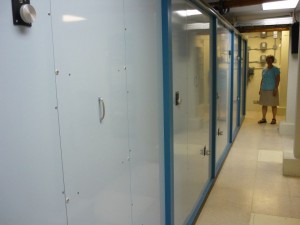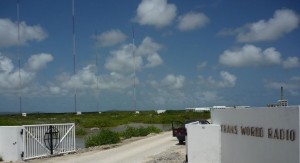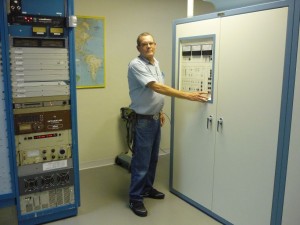During devotions this morning the FM transmitter went off the air. It was quickly determined that the cause was a power failure and, with no backup power, it did not return until after lunch. This is a small 600-watt transmitter broadcasting to the people of Bonaire.
The automation system has now been programmed to give me a call when the transmitter reduces power so we will be more aware of what is happening, and maybe find a solution. Joe Barker also tried to set up a laptop computer so that I could increase the power back to normal from home when this happens. Unfortunately, it did not work from the place where we are staying, so we’ll have to think about this some more. Transmitter control can be done via my cell phone, but it is very cumbersome and I can not verify whether corrective action has actually taken place.

The phasor for the four tower switchable array is much bigger than the transmitter. The antenna system has three patterns -- north, south and non-directional.
The above efforts took a considerable amount of time so I only got to the site about 3pm. Picked up on the spare PA Module repair that was started yesterday. Managed to locate most of the spare parts, needed to make the repairs, including one spare fuse, which had a different number than the manual specified. Also gained access to all the faulty parts in the module after taking out lots of screws. Now to remove the faulty parts from the circuit boards. I’ll need to get the soldering station from town. Also need a thin wall 5mm socket or nut driver with a maximum outside diameter of 7mm. Can find nothing at the site or in town with thin enough wall. May have to get a socket and grind it down on the lathe.
Hopefully there will be more obvious progress tomorrow.
Another thing I discovered this morning is that the odd fuse that was blown in the PA module is only rated at 150 vdc rather than 500 vdc like the other proper ones. This could have been the cause of added damage with the initial failure. The one I discovered this afternoon in stock is a Ferraz Shawmut A5Y20-2 which is a direct replacement for the Buss Limitron KLM-20 fuse(s) that are needed.
This evening, we learned that plans to pack the 50,000-watt AM transmitter tomorrow morning in Elkhart has been delayed due to the shipping company’s inability to determine whether it will be able to connect with the ship leaving for Africa on October 23 and arriving there on December 5. TWR Swaziland would prefer it not get held up and incur storage fees should it arrive during the long holiday breaks by customs and others over Christmas and New Years.
NOTE — To see a bigger (and in some cases, expanded) version of any of the photos in this blog, just double click on the one you want to see.



